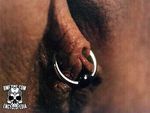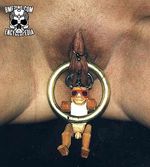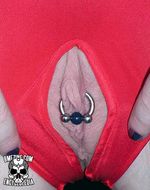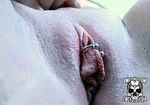Triangle Piercing
The triangle piercing is a piercing that passes underneath the clitoral shaft. It is believed that it was first done by Lou Duff of Gauntlet in 1991, although it is likely that it was performed without recognition at some point before that and never documented. The piercing is so named because the tissue at the point where the inner labia and hood meet feels like a triangle when pinched. It should be pointed out that the piercing does not actually pass underneath the clitoral depth-wise, but in terms of being closer to the vagina (ie. "below" the shaft would be a deep hood, which some women not suited anatomically for a triangle get).
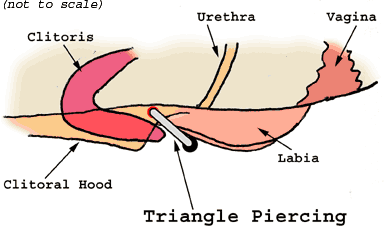
|
Many women hold the triangle to be the ultimate in female piercings. It is a ring (or sometimes barbell) passing underneath the clitoral shaft, in theory offering stimulation not possible either manually or with other piercings. Some women have experienced desensitization over time, but this is rare. This piercing is anatomy-dependant and requires an experienced piercer — accidentally intersecting the clitoral shaft when piercing is at a minimum very painful, and could do damage to nerve structures in the area!
It should be noted that while triangles tend to heal well, like many genital piercings they may bleed on and off for a few days. Anne Greenblatt adds,
"Women with a narrow pubic area and/or large outer labia or whose thighs compress the pubic area may find this piercing uncomfortable because the ring will have a tendency to twist. In this case, a symmetrical teardrop shaped ring is often more appropriate than a round ring. The tapered shape of the ring prevents it from getting caught between the outer labia and painfully twisted and pulled which can cause the piercing to migrate or tear during healing. Most frequently used dimensions are 1/2" wide x 5/8" long. Wearing a thicker gauge will also reduce the risk of migration or tearing caused by twisting of the jewelry."
